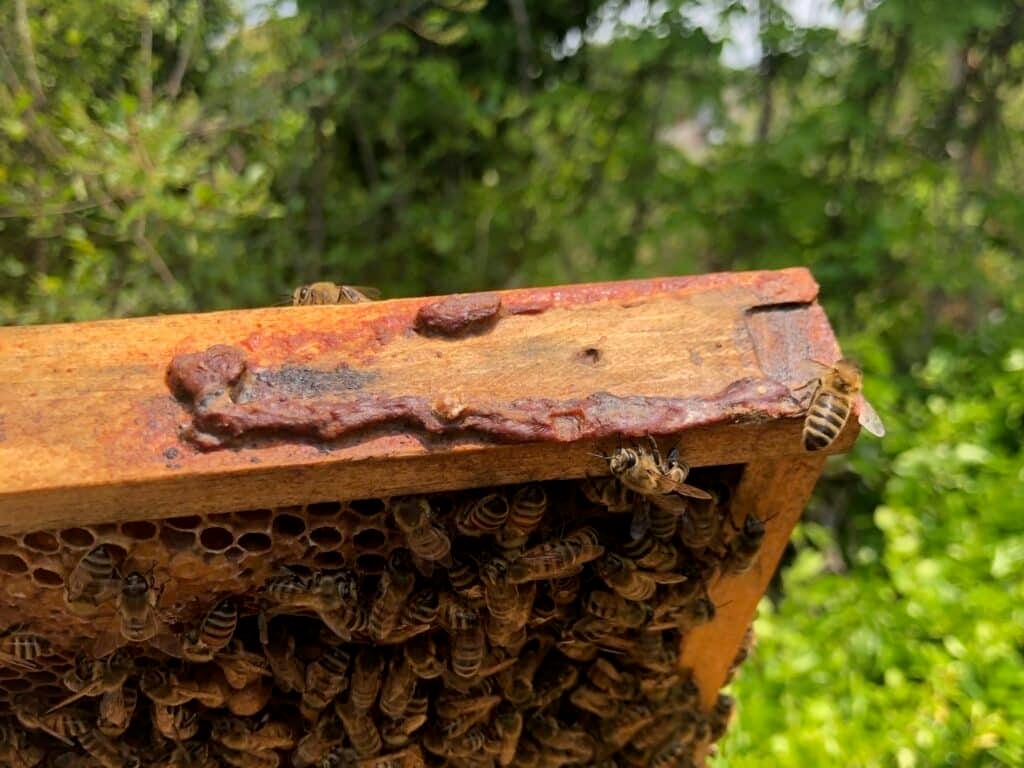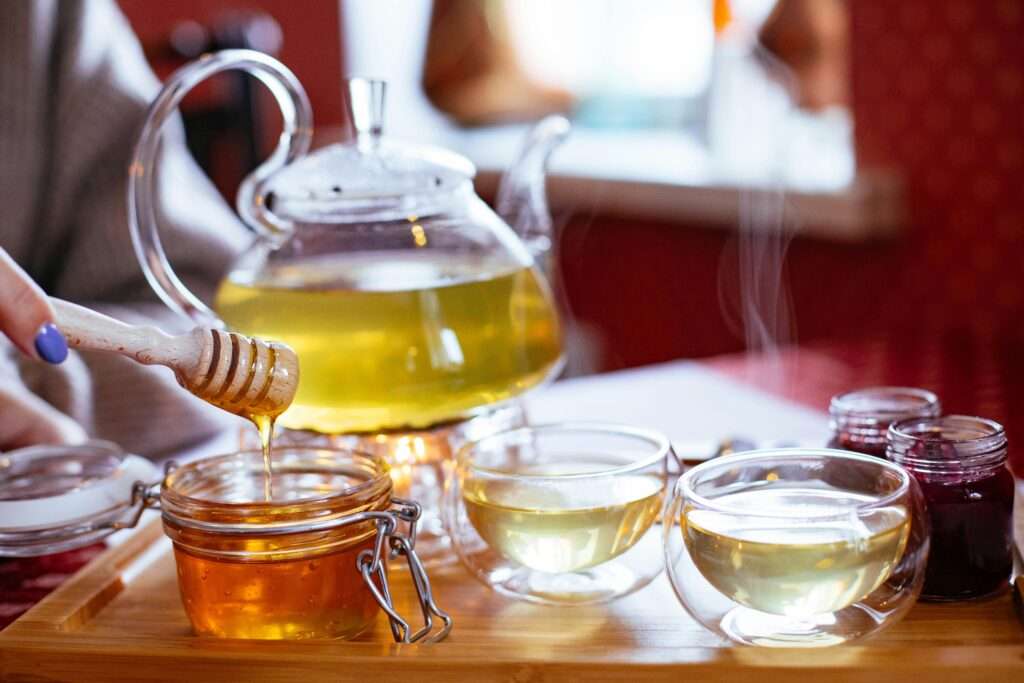Here’s what you’ll need to ensure a successful fermentation
Essential Equipment
Before starting your mead-making journey, you’ll need specific equipment to ensure a clean, successful fermentation.
The key items include a primary fermenter (5-gallon food-grade bucket or glass carboy), airlock and rubber stopper, sanitizer (Star San or similar), hydrometer, thermometer, siphon hose with racking cane, and long-handled spoon[1][2][3].
For bottling, you’ll need bottles, corks or caps, and a bottle filler[1].
Warning: you need to be at least 21 years old to make or drink alchol in the United States
Core Ingredients
Mead requires just three basic ingredients: honey, water, and yeast.
The honey-to-water ratio determines your mead’s final sweetness and alcohol content.
For a one-gallon batch, use 2-3 pounds of honey for dry to semi-sweet mead, or up to 3.5 pounds for sweet mead[4][5][6].
Spring water is preferred over distilled water because it contains trace minerals that yeast need for healthy fermentation[7][8].
Yeast Selection
Choosing the right yeast is crucial for your mead’s character. Lalvin D-47 is widely considered the gold standard for mead making, fermenting cleanly with minimal foam while preserving honey characteristics[9][10].
Other excellent options include Lalvin 71B-1122 for lower alcohol meads (14% tolerance), Lalvin EC-1118 for high-alcohol traditional meads (18% tolerance), and Red Star Premier Cuvee which has shown exceptional results in taste tests[11][12][13].
Step-by-Step Process
Preparation and Sanitation
Everything that contacts your mead must be sanitized[14][15].
Clean all equipment first, then sanitize using Star San (60-second contact time) or a bleach solution (1 tablespoon per gallon, rinse thoroughly)[14][16][17].
This step is critical—poor sanitation is the leading cause of mead failures[14].
Creating the Must
- Warm the honey in a water bath to make it easier to pour[18]
- Add honey to your fermenter with half the total water volume
- Mix thoroughly until honey completely dissolves[18][5]
- Top off with remaining water to reach your target volume
- Take a hydrometer reading to record your original gravity (OG)[7]
Yeast Preparation and Pitching
Rehydrate dry yeast in warm water (104°F) for 15 minutes, ideally with GoFerm nutrient[7][19].
Once your must cools to 80°F or below, pitch the yeast and install your airlock[20].
Modern Nutrient Management: TOSNA
Traditional mead-making took months or years, but modern techniques using TOSNA (Tailored Organic Staggered Nutrient Addition) can complete fermentation in 2-4 weeks[21][22][19].
TOSNA uses Fermaid-O (organic yeast nutrient) added in four equal doses:
This method prevents stuck fermentations, reduces off-flavors, and produces cleaner-tasting mead[22][19].
Fermentation Management
Temperature Control
Maintain fermentation temperatures between 65-75°F[20][23].
Some yeasts like Lalvin D-47 prefer cooler temperatures (63-65°F) for optimal flavor development[24].
Higher temperatures can produce harsh fusel alcohols, while lower temperatures may cause sluggish fermentation[24][25].
Daily Care
During the first week, gently swirl the fermenter daily (without airlock) to:
- Keep yeast in suspension
- Add oxygen for healthy fermentation
- Remove excess CO2[7]
Add nutrients slowly while the fermenter is in the sink to prevent explosive foaming[7].
Racking and Aging
After primary fermentation (2-4 weeks), rack to a secondary fermenter to separate the mead from dead yeast sediment[26].
This process, called racking, should be repeated every 2-3 months during aging[27].
Most meads benefit from 3-6 months of aging before bottling[27].
Stabilization and Bottling
Before bottling, ensure fermentation is completely finished by taking stable gravity readings.
For long-term storage, stabilize with potassium metabisulfite (1/4 teaspoon per gallon) and potassium sorbate (3/4 teaspoon per gallon) to prevent refermentation[28][27].
This is especially important if you plan to backsweeten your mead.
Critical Warnings and Safety
Sanitation is Non-Negotiable
Poor sanitation will ruin your batch[14].
Every surface, tool, and container that touches your mead must be properly cleaned and sanitized.
Even a small contamination can produce off-flavors or spoil months of work[14][15].
Bottle Bomb Prevention
Never bottle before fermentation is complete unless you understand carbonation calculations[29].
Residual sugars can cause bottles to explode from excess pressure, creating dangerous glass projectiles[29].
Always verify fermentation completion with a hydrometer.
Temperature Monitoring
Avoid temperature extremes[24][25].
Temperatures above 80°F can stress yeast and produce harsh flavors, while temperatures below 55°F may cause fermentation to stall[25].
Sudden temperature changes can also crack glass carboys.
Chemical Safety
When using sanitizers like Star San, never mix different chemicals as this can create toxic gases[14].
Always follow manufacturer dilution ratios and wear gloves when handling concentrated sanitizers[16].
Honey Quality Matters
Use only pure, unprocessed honey[30][5].
Avoid honey with additives or artificial preservatives, as these can inhibit yeast activity.
Heat-treated honey loses beneficial enzymes and flavor compounds[30].
Timeline Expectations
With modern techniques, you can expect:
- Primary fermentation: 2-4 weeks
- Secondary aging: 2-3 months minimum
- Bottle conditioning: 1-3 months
- Optimal drinking: 6-12 months from start[31][25]
Quick meads using lower honey ratios can be ready in 3-4 weeks, while high-gravity traditional meads may need 6-12 months to reach their peak[25][32].
Making mead successfully requires attention to detail, proper sanitation, and patience.
While the process itself is straightforward, following these guidelines and heeding the safety warnings will help ensure your first batch produces a delicious, safe-to-consume honey wine.
⁂
- https://gotmead.com/blog/making-mead/mead-newbee-guide/the-newbee-guide-to-making-mead-chapter-4-equipment/
- https://www.meadmakr.com/meadmakr-guide/part-ii-meadmaking-equipment/
- https://www.growforagecookferment.com/mead-equipment-ingredients/
- https://getbrewsy.com/blogs/recipes/mead
- https://wildsprout.org/2021/01/30/honey-mead-recipe-1-gallon/
- https://www.reddit.com/r/mead/comments/25fu3z/honey_to_water_ratio/
- https://www.homebrewtalk.com/threads/current-mead-making-techniques.678676/
- https://fermentology.pubpub.org/pub/cwi5cero
- https://www.oculyze.net/mead-yeast-chart/
- https://meadist.com/making-mead/mead-tips-tricks/best-yeast-for-mead-making/
- https://www.meadmakr.com/mead-yeast-primer/
- https://gotmead.com/blog/making-mead/making-mead-articles/yeast-what-to-use/
- https://www.youtube.com/watch?v=-_shVjrZIO4
- https://gotmead.com/blog/making-mead/mead-newbee-guide/the-newbee-guide-to-making-mead-chapter-12-sanitation/
- https://meadmaking.wiki/process/sanitation
- https://madalchemead.com/clean-sanitize-mead-brewing-equipment/
- https://www.reddit.com/r/mead/comments/16mc5xv/cleaning_mead_equipment/
- https://homebrewersassociation.org/tutorials/how-to-make-mead/how-to-make-mead/
- https://boomchugalug.com/blogs/news/tosna-for-beginners-a-complete-guide-to-staggered-nutrient-additions-in-mead-making
- https://winemakersdepot.com/Mead-Making-Tutorial
- https://boomchugalug.com/pages/the-ultimate-tosna-2-0-mead-nutrient-calculator
- https://www.meadmaderight.com/nutrient-additions
- https://gotmead.com/community/threads/ideal-temperature.13442/
- https://www.reddit.com/r/mead/comments/rbqfuh/fermenting_temperature/
- https://fermentology.pubpub.org/pub/jv6mzwbr
- https://www.hiddenlegendwinery.com/discover-3-stages-mead-making/
- https://monkeyboymead.com/meadmaking/bottling/
- https://meadmaking.wiki/process/stabilization
- https://www.reddit.com/r/mead/comments/1d4cvej/how_early_can_you_safely_bottle/
- https://www.youtube.com/watch?v=VTudpZD3uLo
- https://beersmith.com/blog/2021/01/24/mead-making-fundamentals-part-1/
- https://users.soe.ucsc.edu/~karplus/mead-recipe.html
Ad – Amazon Associate Store














